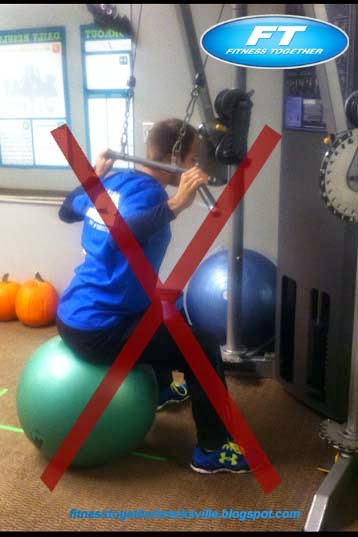Trainer
Tuesdays
Welcome back to the weekly edition on Trainer Tuesdays. Make sure to check in at our blog every Tuesday evening to learn the expertise of our great staff. Aside from being fantastic exercise coaches, they are also extremely knowledgeable in many aspects of health and fitness; so, it's time that you get to know them a little better! Each week, we will post a frequently asked, or sometimes just a fun fitness related question followed by the answers of each of the trainers at Fitness Together Brecksville.
In Your Opinion, What are the Top 3
Most Dangerous Exercises and Why?
This might come as a surprise, but the bench press is one of them. The
bench press can ruin your shoulders if executed improperly. Most gym goers will
try to go heavy, which leads to the weight coming down over their shoulders
instead of their lower pecs. In addition to this, the lower back is excessively
arched in order to press the heavy weight. Lowering the weight to the
shoulder can lead to pain and injury in the joint. It's important to keep your
arms tight to the body with your forearms moving straight up and down.
Better yet, try incorporating dumbbells into your chest routine. Dumbbells
activate more stabilizers and target the lower pecs better than a barbell.
Another potentially dangerous exercise is the deep lunge. When you put
a loaded bar on your shoulders and lunge forward so far that your calf meets
your hamstring, you put undue pressure on the knee joint. A safer way to
perform the lunge would be to step forward just enough so that your knee joint
forms an angle just under 90 degrees.
One final exercise is the deep pullover. The pullover is great for
stretching the lats, but you don't want to let your arms go too far back. This
occurs when your elbows go past your forehead. This puts unnecessary stress on
the shoulder joint and can lead to rotator cuff injury. To get the most from
the movement and avoid shoulder impingement, reverse the motion as soon as your
elbows get to forehead level.
Remember , with every exercise, always focus on proper form instead of
lifting too heavy. I always like to say, Check your ego at the door!
Monika Cotter: Any exercise can be dangerous If it is not done with
proper form, but for me I believe the top three most dangerous are a lat
pull-down behind the head, the deadlift and barbell back squat. A lat pull-down
behind the head places too much stress on the shoulder joint and over stretches
the ligaments and tendons of the shoulders. The deadlift (and the Romanian deadlift)
can be dangerous because people may not have proper form or try to do too much
weight which can cause injury to the spine. Remember to always keep a flat
back! Last but not least.. one of my favorite exercises- the barbell back squat
(or any squat for that matter). With the squat, once again form is everything!
There are so many crucial things to remember while performing this exercise
that it is almost easy to forget something and injure your back or knees. As a
person adds more and more weight to the barbell it is adding more and more
weight to the pressure on the spine and the knees.
Exercising is great for your body, mind and soul so it should be done consistently; just remember to always be cautious, use proper form and listen to your trainer.
Exercising is great for your body, mind and soul so it should be done consistently; just remember to always be cautious, use proper form and listen to your trainer.
Bronson Rotaru: My 3
exercises to stay away from are the behind-the-neck lat pull-down and behind –the-neck
shoulder press, the deadlift and thirdly any exercise that causes you specific
pains. Looking at the behind-the-head lat pull-downs or military press, it is
important to know that you can gain all the proper benefits from doing the
exercise in front of you without suffering from any anatomical risks
involved. The main risk involved is unnecessary stress to the neck; and
with the pull-down you risk pinching of the rotator cuff muscles. On to the
deadlift, this is a fantastic movement if done properly, but it is commonly
performed wrong. There cannot be any rounding of the back whatsoever. When
performing the deadlift you want to keep your back pretty straight (with a
slight arch) do not round or flatten your back at ANY time throughout the lift.
You can use two different style grips (overhand underhand or both overhand) when
you finish the rep you'll want to lower the weight using your back and legs in
a controlled manner. Trying to perform a deadlift improperly can set you back
months if you hurt your back. It is very easy to injure. If you are unsure
about the move, don't do it. Finally I suggest avoiding any exercise that gives
you pain. We are all differently shaped and sized; and people struggle with
pain in basic moves. It is ok to avoid lateral raises if they cause shoulder
pain, etc. You know your body best, so listen to it!
Steven Madden: Of
course exercise is great for maintaining a healthy body. So why would you risk doing dangerous
exercises and risk injury? Of all the
dangerous exercises out there, these are my top three.
First is the box jump. Now
I don't mean a 12"-24" box jump. I mean a jump that is anything higher. While a good exercise when dealing with
manageable heights, the level of risk skyrockets with more, and it does not
really add much to a person's overall jumping height. The reason is that the technique to do a box
jump is not how athletes jump in almost any sport, not even the high jump. All you are doing by trying to do a four foot
box jump is risking a 4 foot fall to the floor, potentially shredding the skin
off your shins, and potential risk to joints and ACL when you heed the call of
gravity to the floor.
Next I am not a fan of the Barbell Jump Squat. Let's remember where we rest the bar during a
squat, on the shoulders, resting against the neck. What happens when we jump in the air, and we
don't hold the bar against our shoulders the whole time? That's right, it slams against your spine. Do I need to explain anymore?
The last exercise I consider dangerous is actually a category of
exercises: the Olympic lifts. Now again,
this is all how you look at it. These
lifts (the clean and jerk, and the snatch) are dangerous to begin with, but you
can always increase that danger. What I
would like to point out about these lifts, so named because they are the lifts
done in the Olympics, is that when competing, participants only lift three
times. That is it. Now, there is a disturbing trend in fitness
to do these lifts in high volume, high rep sets, that increases the risk
exponentially. These are complicated and
technical moves that are difficult to perform.
Doing them under excessive fatigue puts huge stress on the joints,
tendons, and muscles. There are much
less riskier compound exercises that can be performed at higher reps, so why
risk it?
Kelly Bailey:
All exercises, whether cardiovascular or resistance training, pose
inherent risks to participants. Most of us exercise because the benefits
outweigh those risks. However, there are some exercises that pose greater risks
than others. In my opinion, the three resistance training exercises that pose
the greatest risk are squats, deadlifts, and lunges. Keep in mind that these
three exercises are also, when done correctly, some of the most efficient at
producing great results. People tend to get injured more often when
performing these exercises for a few reasons. First, I often notice
how few people actually warm up before performing these kinds of exercises. At
minimum, you should perform 5 to 10 minutes of a cardio-type warm up,
followed by some body-weight repetitions that mimic the exercise you will
be performing. The other reason people tend to get injured performing
these exercises is because they don't execute proper form, or
they use weights that are too heavy, thereby making it impossible to execute
proper form. The remedy for this is to work with a trainer or someone
experienced in resistance training that can help cue you on form. Start
out with body-weight exercises and slowly (over a period of weeks or months)
work into heavier weights. Form should always be your number one
priority.
Taynee Pearson: Most exercises will be dangerous if you do not
practice proper form while doing them but the 3 most dangerous would be a
deadlift, a kettlebell swing, and an Olympic snatch. Proper form while doing a
deadlift is very important, most people want to bend their back while doing it
and this can put a lot of strain on the lower back if the hips aren't used
properly. The kettlebell swing is dangerous as not many people use proper form
while doing them. Your back should be straight, making sure you squat down and
don't bend your back at the bottom of the swing. The Olympic snatched dangerous
mostly for the back and shoulders. If proper form is not practiced, it's an
easy exercise to dislocate your shoulder.
Lisa Clark: Exercising is something that we all know has so many health benefits, however it is so important to know which exercises to do, which not to do and to make sure you maintain proper form while performing them. You must first take into account your health and possible issues your body may have. If you have back issues or knee issues there are exercises you will want to stay away from. Same thing if you have any issues with your shoulders. However there are a few exercises that in my opinion aren't really safe and should be avoided by most everyone. The first exercise is a leg extension. A leg extension is an example of an isolated exercise that only works one muscle. While performing a leg extension you're causing the kneecap to draw back onto the thigh bone and causes a grinding type motion which can be harmful to your knees. Test have also proved that they aren't as effective at stimulating the quadriceps as doing exercises such as squats, leg presses or lunges.
Two more exercises I don't feel are
safe and can be performed other ways to get the same benefit without the
possibility of injury, are behind the neck shoulder presses and behind the neck
wide grip lat pull-downs. Performing these exercises puts your shoulder in the
weakest position and in a position that can cause impingement of the rotator
cuff. The position of your neck during these exercises also can increase your
chance of impingement of the rotator cuff not to mention it puts a lot of undue
stress on your cervical spine. A safer way to perform both of these exercises
is simply to position the bar in front of you instead of behind your neck. It
will be just as effective without the same risks of injury.
©
2014 Fitness Together, Inc. All Rights Reserved. Powered by Fusionbox.
About | Contact | Franchise | Suppliers | History | Leadership | NutritionTogether |Sitemap | PrivacyPolicy | TermsofUse | Facebook | YouTube | Twitter | Linkedin



No comments:
Post a Comment